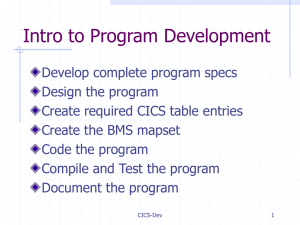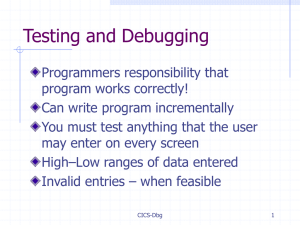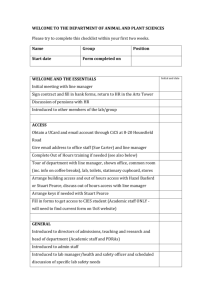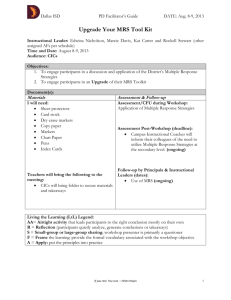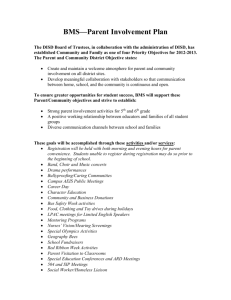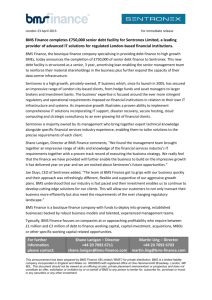ibm mainframes - Mainframes Online Training
advertisement
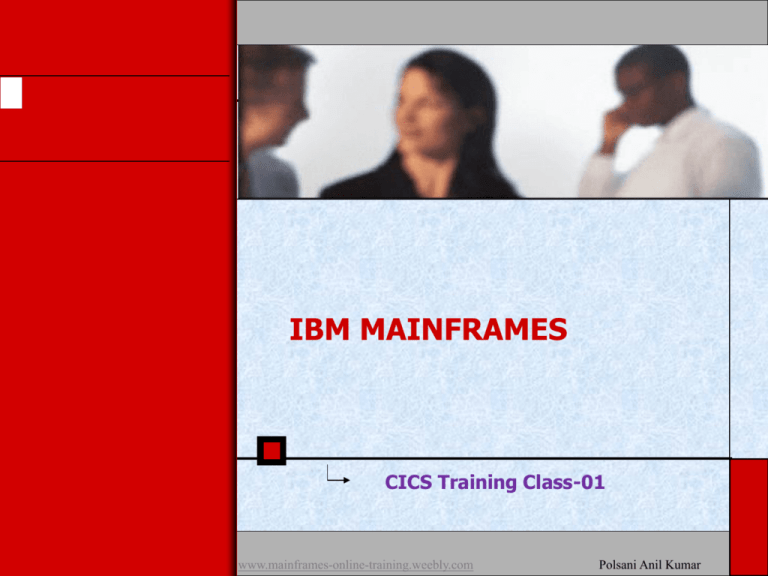
IBM MAINFRAMES CICS Training Class-01 www.mainframes-online-training.weebly.com Polsani Anil Kumar Typical mainframe workloads Most mainframe workloads fall into one of two categories: batch processing or online transaction processing. Batch processing One key advantage of mainframe systems is their ability to process terabytes of data from high-speed storage devices and produce valuable output. The applications that produce these statements are batch applications, that is, they are processed on the mainframe without user interaction. A batch job is submitted (through JCL) on the computer, reads and processes data in bulk (perhaps terabytes of data), and produces output, such as customer billing statements. Online Transaction Processing Transaction processing that occurs interactively with the user is referred to as online transaction processing (OLTP). Transaction systems must be able to support an unpredictable number of concurrent users and transaction types. Most transactions are executed in short time periods. These systems are currently supporting missioncritical applications; therefore, continuous availability, high performance, and data protection and integrity are required. Difference Between Batch And Online Batch System Online System Input data prepared before the execution Data is prepared at the time of execution as needed Processing sequence is predictable Processing sequence is unpredictable Programs and files can't be shared Programs and files can be shared Programs are scheduled through JOBS Programs are initiated through transactions any time Recovery and restart is easy Recovery and restart requires additional process Introduction To CICS CICS stands for customer information and control system CICS can be used two different levels Developed in late 1960’s as DB/DC control system CICS provides an interface between the operating system and application program. Macro level CICS initial version operated by assembler macros to request CICS services Command level CICS high level language version operated under command which can replace series of macros CICS & Operating System Operating System CICS Application Program Terminal DATASETS DATABASE CICS Components Control Programs: these are the program that actually provide the interface between the operating system and application program to handle general functions of CICS Control Tables: this defines the CICS environment. Functionally associated with control programs. To execute any program (TASK) in CICS we need to specify/define the program name in this table which further used by control program to execute (INITIATE). Control Areas contains the system type information about the task and transaction Control Tables And Control Programs Control Table Control Program Processing Program Table PPT PCP Program Control Program Program Control Table PCT KCP Task Control Program File Control Table FCT FCP File Control Program Terminal Control Table TCT TCP Terminal Control Program Temporary Storage Table TST TSP Temporary Storage Program N/A SCP Storage Control Program N/A ICP Interval Control Program BASIC MAPING SUPPORT www.mainframes-online-training.weebly.com Polsani Anil Kumar Introduction To BMS The primary function of BMS is To design a screen with BMS macros To remove device and format dependency To provides Text handling To terminal Paging and Message Routing Map And Mapset Any screen developed with help of BMS macros is known as MAP and collection of one or more maps is known as MAPSET Multimap Panel : Single panel with two or more maps in it at once. Multiple Map: Single screen with two or more maps in it but one at a time To design a MAPSET: We can use either assembler language i.e., BMS MACROS or SDF (SCREEN DEFINITION FACILITY) Tool Map Fields Fields are of two types : Label Field Data Value Field Label fields used to specify the label tags on the screen to specify information Data value fields which can be used to pass the data between map and program Label fields does not contain names in name field where as data value filed does, which are used to create symbolic map data items. BMS Macros DFHMSD: DATA Facility Hierarchy Mapset Definition used to define a mapset and its characteristics and to specify end of the mapset Only one mapset is allowed in one assembly program DFHMDI Map definition interface used to define a map and its characteristics. More than one map can be defined in a mapset program DFHMDF map definition field used to define a field and its characteristics. More than one filed can be defined with-in a map BMS Mapset Code Sheet 1 8 9 14 15 16 1-7 mapset /map/field name 8 Blank 9 – 14 BMS macros 15 blank 16-71 Parameter filed 72 continuation purpose denoted by symbol ‘X’. 72 STRUCTURE Of BMS Mapset Program Name Field Macro Field Parameter Field MAPSETNAME DFHMSD TYPE=&SYSPARM DEFINE A MAPSET MAPNAME1 DFHMDI SIZE=(24,80) FILEDNAME DFHMDF POS=(10,30) FILEDNAME DFHMDF POS=(15,40) . . MAPNAME2 DFHMDI SIZE=(24,80) FILEDNAME DFHMDF POS=(10,30) FILEDNAME DFHMDF POS=(20,40) . . DFHMSD TYPE=FINAL END DEFINE A MAP FILED FILED MAP FILED FIELD MAPSET END Preparation Of CICS Mapset BMS ASSEMBLY PROGRAM PARM=SYSPARM(DSECT) ASSEBLER COMPILER PARM=SYSPARM(MAP) ASMA90 SYMBLOIC MAP PHYSICAL MAP LINKAGE EDITOR LOAD MODULE Types Of Maps There are two types of maps: Physical & Symbolic Physical map which represents a load module used in CICS region for execution. Ensures device independency The mapset name max can be up to 8 characters. 1-7 mapset name used defined used in the program 8th byte character is suffixed by the system at run time based on the device used MAPSET should have an PPT Entry Symbolic map which represents a copy book containing all the data item declaration used in the application program. Ensures format independency. My First BMS Map Design MAPSET1 DFHMSD TYPE=&SYSPARM, X LANG=COBOL, X MODE=INOUT, X TIOAPFX=YES, X STORAGE=AUTO, X CRTL=(FREEKB,ALARM,FRSET) ******************************************************** MAP1 DFHMDI SIZE=(24,80), X LINE=1, X COLUMN=1, X JUSTIFY=LEFT ******************************************************** DFHMDF POS=(11,30), X LENGTH=28, X ATTRB=PROT, X INITIAL='WELCOME TO SAHASRA INFO TECH‘ ******************************************************** DFHMSD TYPE=FINAL END Entry Required For Mapset MAPSET should have an PPT Entry. Command to create an entry in PPT. CEDA DEF MAPSET(MAPSET NAME) G(GROUPNAME) CEDA INS MAPSET(MAPSET NAME) G(GROUPNAME) Command to send the map onto the screen. CECI SEND MAP(MAP NAME) MAPSET(MAPSET NAME) Thank You Polsani Anil Kumar www.mainframes-online-training.weebly.com Polsani Anil Kumar
